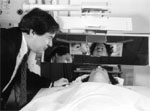Cultured eyes
 there is hope in sight for the blind. For the first time in medical history lab-grown corneas have been developed by us scientists. The lab variety resemble the real ones in every respect, even to the degree of cloudiness human corneas get when they come in contact with detergents, shampoos and cleaning agents, according to May Griffith of the University of Ottawa Eye Institute and Mitchell Waste of the University of Tennessee in Memphis who developed them.
there is hope in sight for the blind. For the first time in medical history lab-grown corneas have been developed by us scientists. The lab variety resemble the real ones in every respect, even to the degree of cloudiness human corneas get when they come in contact with detergents, shampoos and cleaning agents, according to May Griffith of the University of Ottawa Eye Institute and Mitchell Waste of the University of Tennessee in Memphis who developed them.
Tests have shown that they resembled human corneal tissue in structure, biochemistry and the way they conduct electrical signals. A report in the New Scientist, quoting the researchers, said the artificial corneas can be used for research and may save millions of animals from cosmetic or medical tests.
According to the director of Ottawa Eye Institute Bruce Jackson: "This might just be the solution we need to meet future demands and restore eyesight to many eyes.'
Related Content
- Hawaii’s Waikiki Beach 'could soon be underwater' because of rising sea levels caused by climate change
- The discoloration of the Taj Mahal due to particulate carbon and dust deposition
- MP tourism corporation eyes tribal culture to woo tourists
- Budget 2013-2014: speech of P. Chidambaram, Minister of Finance
- Nokrek Biosphere Reserve needs more devp fund
- Cholera: hawk eye on areas where suspected cases live
